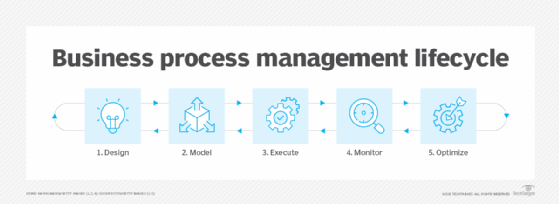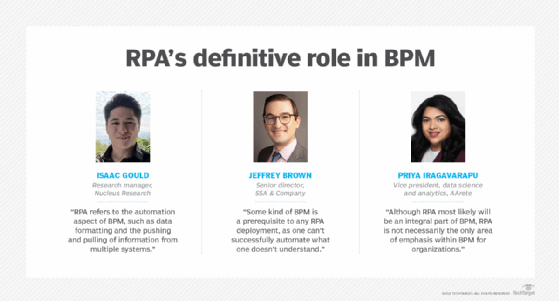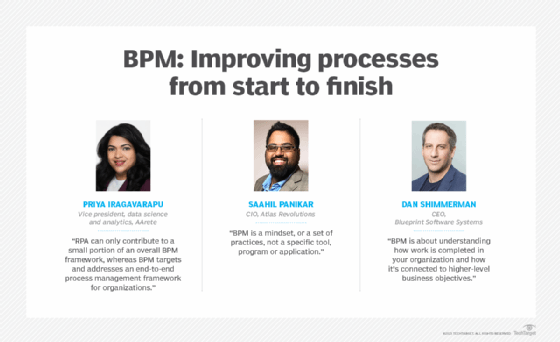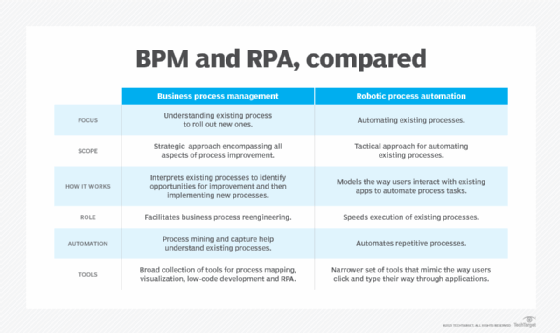RPA vs. BPM: How are they different?
Don't confuse RPA with BPM. These process-oriented initiatives are distinctly different but also highly complementary when planning, automating and improving business operations.
Robotic process automation and business process management are complementary partners in driving digital transformation initiatives. RPA has received more publicity in recent years, but BPM is an essential discipline for enterprises and a key enabler in scaling RPA projects.
RPA differs from BPM in several ways, but most significantly, RPA automates a specific set of tasks while BPM determines what tasks to automate and the steps needed to eliminate or consolidate those tasks.
It's worth noting that from a software perspective, the tools developed for both approaches are starting to converge. Many early leaders in BPM platforms, such as Pega and Appian, have increased their emphasis on low-code, process automation and AI capabilities. Meanwhile, RPA pioneers, like UiPath, Automation Anywhere, and SS&C Blue Prism, have expanded into tools that interpret existing business processes and automate the rollout of new processes in addition to simply automating existing processes.
What is RPA?
RPA programmable software, or bots, automates manual, repetitive, rules-based tasks by mimicking the way humans click and type through typical business applications, freeing up employees to work on more value-critical tasks. RPA can also automate access to legacy systems that lack a modern API.
Early RPA implementations were somewhat brittle and inflexible, which limited the number of bots deployed in many businesses. Consequently, Gartner coined the term hyperautomation as a way of characterizing a collection of technologies for automating bots at scale. Hyperautomation combines various technologies to create more automated workflows in such applications as process mining, machine learning and low-code/no-code development environments.
What is BPM?
BPM is a business discipline that helps organizations better understand and improve the business processes they use to operate. The insights they gain from BPM enable organizations to streamline workflows, boost overall productivity, eliminate waste, lower costs, and increase agility, scalability and process efficiency. BPM builds on the early scientific management approach by Frederick Winslow Taylor with the incorporation of modern techniques for improving process quality and efficiency, including those pioneered by Peter Drucker and the total quality management and Six Sigma methods.
BPM has traditionally required process experts to manually craft process diagrams by watching and interviewing business users. This is called business process mapping (which confusingly sometimes gets shortened to the same acronym as business process management). These diagrams were often captured as a business process modeling notation using visual diagramming tools like Microsoft Visio. The resulting files were static and required additional work to implement. But that approach has started to change with the development of better tools to automatically capture processes, highlight opportunities for improvement and implement new workflows.
BPM is as much a cultural as it is a technical discipline. To improve processes, employees must be willing to accept change and eliminate unnecessary tasks, while adding new tasks.

RPA and BPM: How to use each separately -- and together
Here is an analysis of how RPA and BPM are used separately and in tandem.
Tactical vs. strategical deployments. Most RPA initiatives start with a BPM process to capture an overview of business operations. "Some kind of BPM is a prerequisite to any RPA deployment, as one can't successfully automate what one doesn't understand," reasoned Jeffrey Brown, senior director at global management consultancy SSA & Company.
RPA is usually deployed tactically as a Band-Aid to a problem until an appropriate platform is implemented or a longer-term technology roadmap pays off. A complete business process map is an excellent tool for discovering and prioritizing RPA opportunities. Process mapping in RPA can also be very targeted to avoid denoting an entire accounting function if the goal is to automate the ingestion of invoices.
Automation vs. monitoring and analytics. RPA and BPM complement each other when deploying and monitoring automated processes. "RPA refers to the automation aspect of BPM, such as data formatting and the pushing and pulling of information from multiple systems," explained Isaac Gould, research manager at Nucleus Research. BPM encompasses the workflow design, monitoring and analytics of RPA tasks and processes.
Marketers, for example, might need to complete a monthly report on how their campaign affects sales. BPM software assigns and notifies the individuals responsible for starting the project. An RPA tool is then triggered to move sales data from a CRM or ERP system to a report builder. As each iterative step is completed, BPM software automatically sends progress reports to project participants for approval and adds a layer of analytics to track how long each step takes to complete and which tasks require the most rework.
Faster vs. better processes. RPA makes any process faster, including a bad one, while BPM can improve an existing process. "Deploying robots to automate tasks in an inefficient process just makes a faster inefficient process," said Miguel Valdes Faura, co-founder and former CEO of open source BPM and low-code development platform provider Bonitasoft. "Approaching business process automation by looking at the whole process end-to-end through BPM implementation results in a better process, [within which] RPA can have its own important role to play."
Despite the recent popularity of RPA, BPM is still the foundation of automated business processes. BPM manages the end-to-end processes, structures and business data, and coordinates how people and systems work together, Faura explained. Using visibility and process data, BPM also provides strategic insights for process improvements and innovations.
RPA can connect BPM processes with the same technologies deployed with other platforms and systems. BPM processes can delegate tasks to RPA robots at the right time and in the proper context.

Implementation vs. understanding. RPA excels at the implementation of process automation, while BPM increases understanding of how those processes work by defining, centralizing and managing process workstreams. "BPM is about understanding how work is completed in your organization and how it's connected to higher-level business objectives," said Dan Shimmerman, CEO of business process design at management platform provider Blueprint Software Systems.
Knowing the sequence of steps in the process, how much they cost, how often they're run, how often they produce errors and the number of variances can help optimize workstreams. In some cases, Shimmerman added, process optimization and retraining might be necessary, while in cases where the process is rules-based, highly repeatable and prone to costly manual errors, RPA deployment might be appropriate.
RPA automates simple, mechanical, rules-based tasks, but enterprises also need to automate decision-based tasks by using intelligent process automation (IPA). BPM can play a role in hyperautomation initiatives that span RPA and IPA by providing information on what processes need to be automated and where AI and machine learning can be applied in the process.
Technology waste vs. bureaucratic waste. RPA and BPM smooth out business operations and eliminate different kinds of waste. RPA eliminates waste in technology systems that use bots to complete software tasks, while BPM eliminates waste in the human hierarchies and bureaucratic rules that shape business processes. "BPM is a mindset, or a set of practices, not a specific tool, program or application," noted Saahil Panikar, CIO at Atlas Revolutions, a digital transformation consultancy. BPM implementation signals a significant change in business architecture, the full impact of which might not be realized for some time. BPM tools help keep stakeholders updated about their business processes during the transition.
BPM tends to involve whole teams or departments to organize and collaborate on business processes companywide, while RPA can be the responsibility of an individual development team or implemented on an as-needed basis to perform individual tasks and processes identified by BPM as promising candidates for RPA.

Task vs. architecture orientation. RPA automates very specific repetitive tasks, while BPM encompasses an organization's end-to-end architecture and process management. "Although RPA most likely will be an integral part of BPM, RPA is not necessarily the only area of emphasis within BPM for organizations," said Priya Iragavarapu, vice president of data science and analytics at global management consultancy AArete.
BPM plays a role in the strategy, planning, technology and execution of business processes. RPA typically enters in the last two phases -- technology and execution. BPM's most critical steps, Iragavarapu said, are appraising the current state of a company's business processes and documenting how the smaller segments of the process fit into the end-to-end framework. Process mapping can produce additional insights into the process flow.

While RPA requires simple decisions to automate specific repetitive tasks, machine learning and predictive analytics can be infused into BPM to enable processes requiring more complex decisions. "RPA can only contribute to a small portion of an overall BPM framework," Iragavarapu explained, "whereas BPM targets and addresses an end-to-end process management framework for organizations."
George Lawton is a journalist based in London. Over the last 30 years, he has written more than 3,000 stories about computers, communications, knowledge management, business, health and other areas that interest him.






